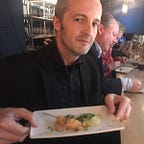24. Wandering Samurai
Treading water
For years I worked as an odd job man in tech. That’s the only way I can describe the life of a consultant, especially one with my profile. I hoped to be able to use my knowledge and experience (and minor fame) to help companies work on cutting edge technologies, pushing the frontiers of knowledge and practice. It turns out consulting is never about pushing the envelope of change. It’s about helping people take baby steps and teaching the basics of something they can’t create the capacity to innovate for themselves.
I got to see work from the outside for the first time. Usually, we’re so embedded in work that we can’t see it for what it is. For most companies it’s easier to make changes by hiring outside help than to rely on the people they’ve employed. The sad truth is that once people have been hired, they are typically condemned to be faceless cubicle workers, no longer viewed as trusted advisors, only as indentured slaves. This is the true face of work in our Western Democracy and everywhere else. Workers become downgraded to cattle or cogs in a machine of production. No one wants or expects anything from us. The mystery is gone. The person has been stamped for basic approval, and categorised for one minor purpose only. Only external advisors can be looked up to.
It was for this precise reason that I resisted being hired by any company. I knew that, as soon as I became an employee of some company, my status would be transformed into that of a minion and my capability to make any kind of…
